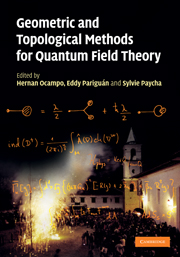Book contents
- Frontmatter
- Contents
- List of contributors
- Introduction
- 1 The impact of QFT on low-dimensional topology
- 2 Differential equations aspects of quantum cohomology
- 3 Index theory and groupoids
- 4 Renormalization Hopf algebras and combinatorial groups
- 5 BRS invariance for massive boson fields
- 6 Large-N field theories and geometry
- 7 Functional renormalization group equations, asymptotic safety, and quantum Einstein gravity
- 8 When is a differentiable manifold the boundary of an orbifold?
- 9 Canonical group quantization, rotation generators, and quantum indistinguishability
- 10 Conserved currents in Kähler manifolds
- 11 A symmetrized canonical determinant on odd-class pseudodifferential operators
- 12 Some remarks about cosymplectic metrics on maximal flag manifolds
- 13 Heisenberg modules over real multiplication noncommutative tori and related algebraic structures
9 - Canonical group quantization, rotation generators, and quantum indistinguishability
Published online by Cambridge University Press: 07 September 2010
- Frontmatter
- Contents
- List of contributors
- Introduction
- 1 The impact of QFT on low-dimensional topology
- 2 Differential equations aspects of quantum cohomology
- 3 Index theory and groupoids
- 4 Renormalization Hopf algebras and combinatorial groups
- 5 BRS invariance for massive boson fields
- 6 Large-N field theories and geometry
- 7 Functional renormalization group equations, asymptotic safety, and quantum Einstein gravity
- 8 When is a differentiable manifold the boundary of an orbifold?
- 9 Canonical group quantization, rotation generators, and quantum indistinguishability
- 10 Conserved currents in Kähler manifolds
- 11 A symmetrized canonical determinant on odd-class pseudodifferential operators
- 12 Some remarks about cosymplectic metrics on maximal flag manifolds
- 13 Heisenberg modules over real multiplication noncommutative tori and related algebraic structures
Summary
Abstract
Using the method of canonical group quantization, we construct the angular momentum operators associated to configuration spaces with the topology of (i) a sphere and (ii) a projective plane. In the first case, the angular momentum operators derived this way are the quantum version of Poincaré's vector, i.e., the physically correct angular momentum operators for an electron coupled to the field of a magnetic monopole. In the second case, the operators one obtains represent the angular momentum operators of a system of two indistinguishable spin zero quantum particles in three spatial dimensions. The relevance of the proposed formalism for the progress in our understanding of the spin–statistics connection in nonrelativistic quantum mechanics is discussed.
Introduction
The connection between the spin of quantum particles and the statistics they obey is a remarkable example of a simply stated physical fact without the recognition of which many physical phenomena (ranging from the stability of matter and the electronic configuration of atoms to Bose–Einstein condensation and superconductivity) would not have an explanation. Nevertheless, the simplicity of the assertion “integer spin particles obey Bose statistics, and half-integer spin particles obey Fermi statistics” stands in bold contrast to its intricate physical origin. Indeed, Pauli's proof of the spin–statistics theorem [Pau40] (improving on earlier work by Fierz [Fie39]), showed that the spin–statistics connection was deeply rooted in relativistic quantum field theory. The path to a rigorous proof of this theorem (from the mathematical point of view) was a long one and involved the efforts of many people (see, e.g., the book by Duck and Sudarshan [DS98b]).
- Type
- Chapter
- Information
- Geometric and Topological Methods for Quantum Field Theory , pp. 344 - 367Publisher: Cambridge University PressPrint publication year: 2010
- 1
- Cited by



